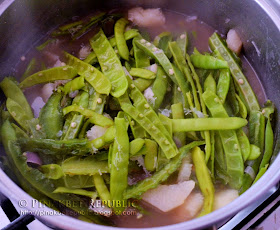 |
| Kappukan nga addaan silsilet. |
Or with a blanched pespes (pinespes, also called papait) or fresh bile added and diluted for bitter-loving Ilokano folks, and in some preparation, bits of liblibro and tualtualia (beef tripes, or the black insides of the large intestines that resembles “pages of a book,” and “towel”, hence the name), and raw beef liver.
Or
with silet (isaw, the small intestines, technically also tripe), cooked rare or
medium rare (blanched or slightly boiled).
The
meat and offal for beef kappukan can
be obtained right in the slaughter house, to assure you of its freshness, from
newly butchered cows. Here, this is the municipal slaughter house of Sanchez
Mira, Cagayan:
There’s
the liblibro at the bottom, left:
These
are pespes ready in cellophane
sachets, to be paired with every purchase of meat and offal for pinapaitan, imbaliktad, or kappukan:
And
here’s the beef for kappukan—the
meat, the liblibro, the tualtualia, and the silet:
Cutting
up, mincing up. The silet is slightly
boiled to tenderize it a bit and remove its raw smell. The liblibro and tualtualia
are to be raw, okey, scald it quickly, but don’t boil it:
Mix
the kappukan thoroughly, season with
salt and pepper and toss it with sliced red onions and minced chili (optional).
Boil the pespes and let it cool first before adding to the mixture. Don’t put
in vinegar or even calamansi, as the
sourness will “cook” the meat, this is supposed to be kappukan or ata-ata so it
should be raw and fresh meat. You can opt to have vinegar with fermented chili
if you want to and just dip the kappukan
in it.
Enjoy
it with your favorite drink!
Here
are more recent kappukans I'm opportuned to have partaken with buddies:
 |
| Preparing kappukan a nuang (carabeef). Note the liblibro and tualtualia. |
 |
| Kappukan a nuang. |
 |
| Another carabeef kappukan, papait to the extreme. |
 |
| Kappukan a baka. |
 |
| Another beef kappukan. Note the raw liver. |
 |
| Kappukan a baka. |
 |
| Pure beef meat kappukan, no tripes. |
::::
































































